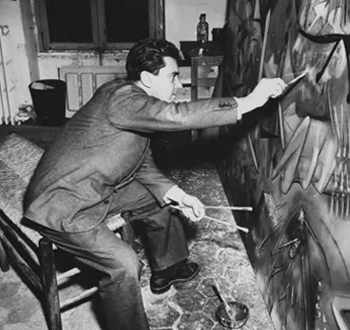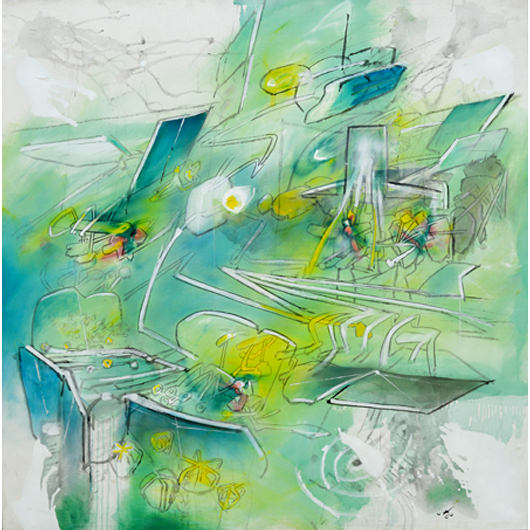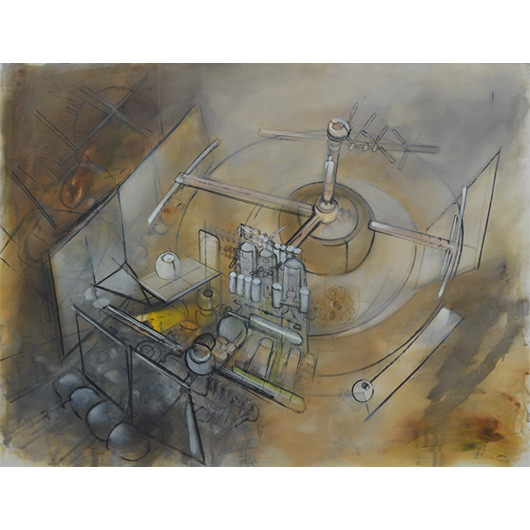Roberto Matta

Roberto Matta (November 11, 1911 – November 23, 2002), was one of Chile’s best-known painters and a seminal figure in 20th century abstract expressionist and surrealist art. Matta was of Spanish, Basque and French descent. Born in Santiago, he studied architecture and interior design at the Pontificia Universidad Católica de Chile in Santiago, and graduated in 1935. That spring, he journeyed from Peru to Panama and completed surreal drawings of many of the geographical features he witnessed. He first encountered Europe while serving in the Merchant Marine after graduating. His travels in Europe and the US led him to meet artists such as Arshile Gorky, René Magritte, Salvador Dalí, André Breton, and Le Corbusier.
Breton was responsible for providing the major spur to Matta’s direction in art, encouraging his work and introducing him to the leading members of the Paris Surrealist movement. Matta produced illustrations and articles for Surrealist journals such as Minotaure. During this period, he was introduced to the work of many prominent contemporary European artists, such as Pablo Picasso and Marcel Duchamp. The first true flowering of Matta’s own art came in 1938, when he moved from drawing to the oil painting for which he is best known. This period coincided with his emigration to the United States, where he lived until 1948. His early paintings gave an indication of the work he would continue, with diffuse light patterns and bold lines on a featureless background. This also marks the period of the “inscape” series, and the closely related “psychological morphologies”.
Prof. Claude Cernuschi writes, “Matta’s key ambition to represent and evoke the human psyche in visual form was filtered through the writings of Freud and the psychoanalytic view of the mind as a three-dimensional space: the ‘inscape’.” According to the essay on Matta in Crosscurrents of Modernism, the inscapes’ evocative forms “are visual analogies for the artist’s psyche”. During the 1940s and 1950s, the disturbing state of world politics found reflection in Matta’s work, with the canvases becoming busy with images of electrical machinery and distressed figures. The addition of clay to Matta’s paintings in the early 1960s lent an added dimension to the distortions.
In his art Matta creates new dimensions in a blend of organic and cosmic lifeforms. During the 1950s, he divided his life between Europe and South America during the 1950s and 1960s, successfully combining the political and the semi-abstract in epic surreal canvases. Matta believed that art and poetry can change lives, and was very involved in the social movements of the 1960s and 1970s. He was a strong supporter of the socialist government of president Salvador Allende in Chile. A 4×24 meter mural of his entitled The First Goal of the Chilean People, was painted over with 16 coats of paint by the military regime of Augusto Pinochet following their violent overthrow of Salvador Allende in 1973. In 2005 the mural was discovered by local officials. In 2008 the mural was completely restored at a cost of $43,000, and is displayed today in Santiago at the La Granja city hall.
Throughout his life, Matta worked with many different types of media, including ceramic, photography, and video production. Matta died in Civitavecchia, Italy on 23 November 2002.
Matta was married twice: his first wife was Patricia Matta Echaurren (née O’Connell), an American (who later married Pierre Matisse), and his second wife was Germana Ferrari. He is the father of six children. Two died prematurely, leaving his creative legacy to artists Gordon Matta-Clark and his twin brother Sebastian, Ramuntcho Matta, Federica Matta, designer Alisée and writer Pablo Echaurren, whose surname was wrongly recorded at birth.
ARTWORKS

Infancy of Concentration, 1983
oil on canvas
53 x 52 ½ inches

Le champs de la mémoire, 1957-60
Oil on canvas
45 ¾ x 59 ½ inches